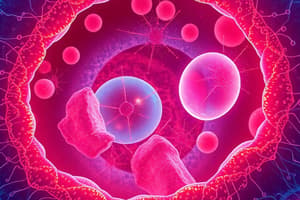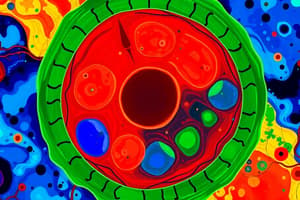Podcast
Questions and Answers
What is the lowest level of organization of matter that has the ability to perform activities attributed to life?
What is the lowest level of organization of matter that has the ability to perform activities attributed to life?
- Cell (correct)
- Organ
- Molecule
- Tissue
Who first used the term 'cell' in biology and when?
Who first used the term 'cell' in biology and when?
- Rudolf Virchow in 1855
- Robert Hooke in 1665 (correct)
- Mathias Schleiden in 1838
- Theodor Schwann in 1839
Which scientist concluded that animals are composed of cells?
Which scientist concluded that animals are composed of cells?
- Rudolf Virchow
- Mathias Schleiden
- Robert Hooke
- Theodor Schwann (correct)
Who proposed that all organisms are made up of one or more cells?
Who proposed that all organisms are made up of one or more cells?
What is the basic unit of structure of all organisms according to the cell theory?
What is the basic unit of structure of all organisms according to the cell theory?
'New cells could only arise from existing cells' - Who made this observation?
'New cells could only arise from existing cells' - Who made this observation?
Where does protein synthesis occur in a cell?
Where does protein synthesis occur in a cell?
Which organelle is known as the 'Roads' of the cell?
Which organelle is known as the 'Roads' of the cell?
What gives Rough ER its rough appearance?
What gives Rough ER its rough appearance?
Which organelle helps in making proteins?
Which organelle helps in making proteins?
Which organelle is responsible for packaging, modifying, and transporting materials within a cell?
Which organelle is responsible for packaging, modifying, and transporting materials within a cell?
What is the function of Smooth ER in a cell?
What is the function of Smooth ER in a cell?
What is the function of cytoplasm vacuoles?
What is the function of cytoplasm vacuoles?
Which of the following is a function of plastids in a plant cell?
Which of the following is a function of plastids in a plant cell?
What gives chromoplasts their yellow, orange, or red color?
What gives chromoplasts their yellow, orange, or red color?
Which organelle is known for temporarily storing starch in plants?
Which organelle is known for temporarily storing starch in plants?
What is the role of chlorophyll in a chloroplast?
What is the role of chlorophyll in a chloroplast?
What is the fluid-filled region enclosed by the two membranes of a chloroplast called?
What is the fluid-filled region enclosed by the two membranes of a chloroplast called?
What is the main function of peroxisomes in the cell?
What is the main function of peroxisomes in the cell?
Which organelle is known as the 'Clean-up Crews' of the cell?
Which organelle is known as the 'Clean-up Crews' of the cell?
What is the main role of microbodies called glyoxysomes?
What is the main role of microbodies called glyoxysomes?
Which cytoskeletal element is responsible for cell shape and movement within the cell?
Which cytoskeletal element is responsible for cell shape and movement within the cell?
What is the structure of centrioles primarily composed of?
What is the structure of centrioles primarily composed of?
Which organelle is abundant in the liver and helps in breaking down fats?
Which organelle is abundant in the liver and helps in breaking down fats?
What is the main function of the cell wall in plant cells?
What is the main function of the cell wall in plant cells?
Which organelle is the site of photosynthesis in green plants and algae?
Which organelle is the site of photosynthesis in green plants and algae?
What is the main component of the cell wall?
What is the main component of the cell wall?
Which organelle is involved in the metabolism of hydrogen peroxide?
Which organelle is involved in the metabolism of hydrogen peroxide?
What is the function of the endoplasmic reticulum in a cell?
What is the function of the endoplasmic reticulum in a cell?
Where is the main genome located within a cell?
Where is the main genome located within a cell?
Flashcards are hidden until you start studying
Study Notes
Fundamental Concepts of Biology
- The lowest level of organization of matter capable of performing life activities is a cell.
- The term 'cell' in biology was first used by Robert Hooke in 1665.
Cell Theory and Discoveries
- Theodor Schwann concluded that animals are composed of cells.
- Matthias Schleiden proposed that all organisms are made up of one or more cells.
- According to cell theory, the basic unit of structure for all organisms is the cell.
- Rudolf Virchow observed that "new cells could only arise from existing cells".
Cellular Functions and Organelles
- Protein synthesis occurs in the ribosomes of the cell.
- The endoplasmic reticulum (ER) is known as the 'roads' of the cell.
- The Rough ER obtains its rough appearance from ribosomes attached to its surface.
- The Ribosomes help in making proteins.
- The Golgi apparatus is responsible for packaging, modifying, and transporting materials within a cell.
- Smooth ER functions to synthesize lipids and detoxify drugs and poisons.
- Cytoplasm vacuoles store nutrients and maintain turgor pressure in plant cells.
Plant Cellular Components
- Plastids in plant cells perform various functions including photosynthesis and storage of products.
- Chromoplasts derive their yellow, orange, or red color from carotenoids.
- The amyloplast is known for temporarily storing starch in plants.
- Chlorophyll in chloroplasts plays a crucial role in capturing light energy for photosynthesis.
- The fluid-filled region enclosed by the two membranes of a chloroplast is called the stroma.
Organelles and Their Functions
- The main function of peroxisomes is to break down hydrogen peroxide and other harmful substances.
- Lysosomes are known as the 'clean-up crews' of the cell, digesting waste materials and cellular debris.
- Glyoxysomes are microbodies that help convert stored fats into carbohydrates during seed germination.
- Microfilaments are the cytoskeletal elements responsible for maintaining cell shape and enabling cell movement.
- Centrioles are primarily composed of microtubules and play a role in cell division.
Specialized Functions
- The smooth ER is crucial for lipid synthesis and detoxification processes.
- The plant cell wall functions primarily to provide rigidity and protection.
- The site of photosynthesis in green plants and algae is the chloroplast.
- The main component of the cell wall is cellulose.
- The peroxisome is involved in the metabolism of hydrogen peroxide.
- The endoplasmic reticulum functions in the synthesis, folding, modification, and transport of proteins and lipids.
- The main genome in a cell is located within the nucleus.
Studying That Suits You
Use AI to generate personalized quizzes and flashcards to suit your learning preferences.




